The Old Sugar Mills & Plantations of PR, Part 2
As mentioned in my last post, the area in South East PR was home to the last Sugarcane haciendas (plantations) and sugar mills. This is evident by the numerous red brick structures still standing from its distant past.
Guayama was the epicenter of this climatic chapter in Puerto Rico’s history.
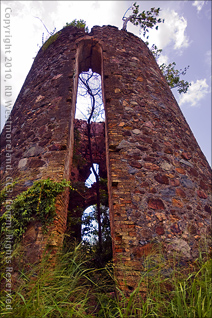 Guayama as a settlement dates to before its founding in 1736 and boasted no less than 200 houses, a church and plaza by 1776. Guayama was also involved in the Spanish American War of 1898. Two battles were fought here, one in Guayama (August 5, 1898) and one North of town (August 9, 1898) as part of a campaign to move on Cayey, then on to San Juan. The war ended before that happened.
Guayama as a settlement dates to before its founding in 1736 and boasted no less than 200 houses, a church and plaza by 1776. Guayama was also involved in the Spanish American War of 1898. Two battles were fought here, one in Guayama (August 5, 1898) and one North of town (August 9, 1898) as part of a campaign to move on Cayey, then on to San Juan. The war ended before that happened.
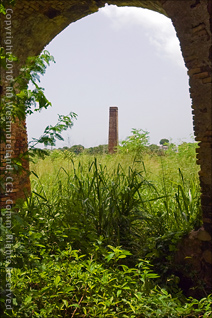 The nickname comes from the fact that African folklore is still celebrated today. This must not be confused with ‘black magic’ or Haitian rituals. There is a week long festival in March, the colorful Brujo Carnival.
The nickname comes from the fact that African folklore is still celebrated today. This must not be confused with ‘black magic’ or Haitian rituals. There is a week long festival in March, the colorful Brujo Carnival.
There are several other fairs to see in Guayama, but the Dulce Sueño Fair is high on the local’s list. A celebration to honor the esteemed Paso Fino horse. I’ve seen a couple of these smaller horses out where I live. They are of Spanish origin and brought to Puerto Rico hundreds of years ago, however the Paso Fino is unique to Puerto Rico as its a mix of 3 specific breeds. A subject I will explore in the future.
The Rise and Fall of Sugar as King-
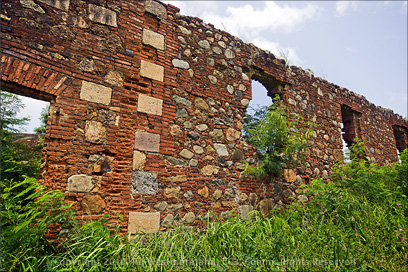 Sugarcane was grown on the island from the earliest days (using slave labor), but took off around 1830. Contraband trade with the US in sugar and molasses can be traced to before this date. Spain realized it could not control this illicit trade so in 1815, they sanctioned formal trade with the colonies. This opened the door for Cuba too. Slave labor, then cheap, unregulated labor after the US assumed control of PR drove the sugar industry. It was not until PR gained it’s “Commonwealth” status that the minimum wage came to bear.
Sugarcane was grown on the island from the earliest days (using slave labor), but took off around 1830. Contraband trade with the US in sugar and molasses can be traced to before this date. Spain realized it could not control this illicit trade so in 1815, they sanctioned formal trade with the colonies. This opened the door for Cuba too. Slave labor, then cheap, unregulated labor after the US assumed control of PR drove the sugar industry. It was not until PR gained it’s “Commonwealth” status that the minimum wage came to bear. 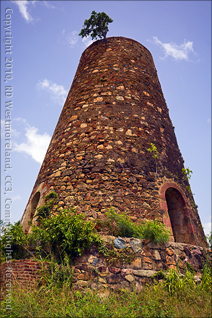 Back then, the cultivation of sugarcane required burning the fields to rid the cane of leaves. Then it was cut down by hand with machetes. That was followed by crushing it in small local mills. Water and steam driven mills did not come into play until late in the 19th century.
Back then, the cultivation of sugarcane required burning the fields to rid the cane of leaves. Then it was cut down by hand with machetes. That was followed by crushing it in small local mills. Water and steam driven mills did not come into play until late in the 19th century.
Very labor intensive to say the least.
All agriculture fell into serious decline in PR as of “Operation Bootstrap” (1940’s) which encouraged manufacture and pharmaceutical development through a series of heavy tax incentives. 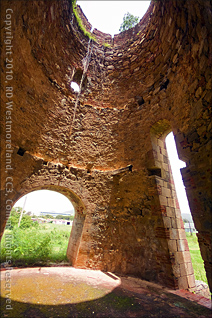 Sugar could not compete with the wages paid to ‘factory workers’ (as meager as they were by US standards) so the sugar industry relocated to Cuba and then to the Dominican Republic. It was all downhill for sugar by the end of the 1940’s.
Sugar could not compete with the wages paid to ‘factory workers’ (as meager as they were by US standards) so the sugar industry relocated to Cuba and then to the Dominican Republic. It was all downhill for sugar by the end of the 1940’s.
Today, ALL of the sugar used
to make Puerto Rican RUM
comes from the DR, but since
it’s distilled and bottled here,
they don’t have to divulge
that little tidbit of info.
Arrg!!!!
The 21st Century-
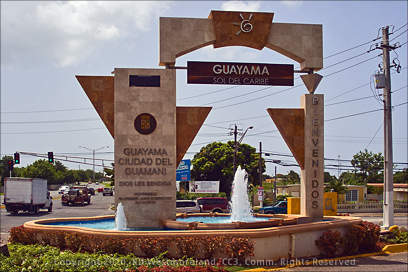 Greater Guayama is typical of most Puerto Rican towns it’s size (about 44,000 per 2000 census).
Greater Guayama is typical of most Puerto Rican towns it’s size (about 44,000 per 2000 census).
Their economy has adjusted with the times and supports it’s self with some agriculture, livestock and some commercial manufacture including pharmaceuticals.
Jobos Bay National Estuarine Research Reserve (2,883 acres) and Aguirre fall within Guayama’s jurisdiction (pronounced Hobo). Jobo is an indigenous fruit bearing tree similar to Mangoes. The Estuary skirts the Eastern edge of Aguirre Central covered in my last post. These Mangrove forests are a good place to go if you are scouting for birds. Manatee can be spotted in the area too. I will make it back to this spot for more shots.
I took Hwy 53 off Hwy 52 to get to Guayama. It was a straight shot without any issues. Worth noting, at that turnoff is a giant steel structure that resembles a bobsled run. 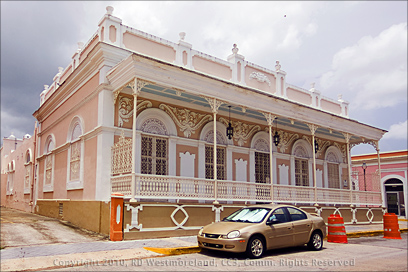 Its actually a huge tail fin sculpture for a grove of palms laid out on the ground like a big airplane. You can easily make it out from the GoogleMap image. We drove through it several times not knowing what it was supposed to be.
Its actually a huge tail fin sculpture for a grove of palms laid out on the ground like a big airplane. You can easily make it out from the GoogleMap image. We drove through it several times not knowing what it was supposed to be.
We were there on a Thursday. It was hot and humid with little air circulation. As hot as being in Ponce. In fact, the South side of the island, down by the coast is almost always hot. Beautiful, but hot. We always pack a small cooler and I was real glad we did today. I had done a pretty thorough job with GoogleMaps this time so I basically knew where I wanted to go. 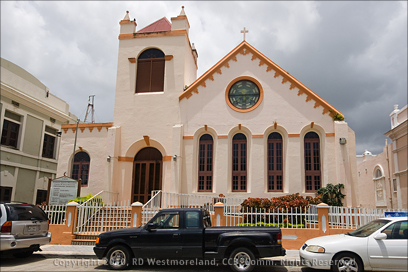 Our first stop was the cool sculptured Welcome sign to Guayama. A strange looking thing. But I liked it.. very whimsical.
Our first stop was the cool sculptured Welcome sign to Guayama. A strange looking thing. But I liked it.. very whimsical.
Then we proceeded to a set of ruins right off the highway. The access to this site was very limited. It was over grown well over my head. I did manage to score a few good shots from the old wind mill used to grind up sugarcane. I tried to hike over to the nearby syrup processor (square chimney), but the growth was simply too thick. I could not see more than a few feet in front of me.
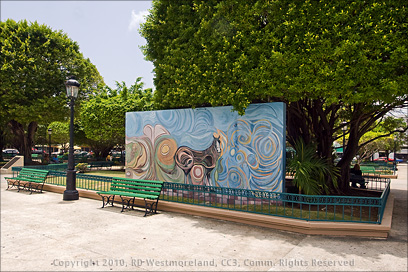 A second set of ruins we visited were back up the road from here. These were from the Hacienda Azucarera Vives. The grounds had a formal gate, but was not locked. The site was obviously being kept clear by the city. I spent a good hour here shooting the remains and plan to come back with better gear later. A small tree growing out of the top of the old mill was like icing on the cake. Most fantastic! I was melting at this point and downed an iced coffee.
A second set of ruins we visited were back up the road from here. These were from the Hacienda Azucarera Vives. The grounds had a formal gate, but was not locked. The site was obviously being kept clear by the city. I spent a good hour here shooting the remains and plan to come back with better gear later. A small tree growing out of the top of the old mill was like icing on the cake. Most fantastic! I was melting at this point and downed an iced coffee.
 From there, we headed on into ‘old town’ where the main Plaza was. I stopped off at the ‘Totem” first for a few shots. Up close, it’s rather phallic looking. A beautifully cut piece of steel sculpture dedicated to Govenor Sila Maria Calderon (2001- 2004) for urban renewal work done in Guayama. From this vantage point, you can see the Hacienda Azucarera Vives on the distant hill.
From there, we headed on into ‘old town’ where the main Plaza was. I stopped off at the ‘Totem” first for a few shots. Up close, it’s rather phallic looking. A beautifully cut piece of steel sculpture dedicated to Govenor Sila Maria Calderon (2001- 2004) for urban renewal work done in Guayama. From this vantage point, you can see the Hacienda Azucarera Vives on the distant hill.
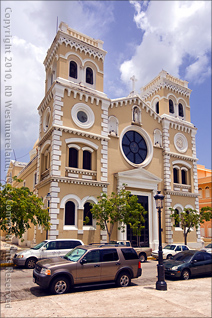 The central Plaza features a very large water fountain (wish it had been on) surrounded by many trees providing shade from the noonday sun.
The central Plaza features a very large water fountain (wish it had been on) surrounded by many trees providing shade from the noonday sun.
Did I mention it was HOT?
As time went on, the haze got thicker and thicker. Off the Plaza was the Mayors office (being remodeled), the Catholic church, an old movie theater converted into municipal offices,  a Methodist church built in 1902, a local Christian radio station, several stores and a Museum. The churches were beautiful. The Catholic church, Iglesia San Antonio de Padua has a clock face painted on one tower set at 11:30 AM. The exact time it was originally baptized. It is the only Catholic church on the island built in the classic neoromantic style. Though I did not go into the museum at Casa Cautino, it is a striking example of late 19th century Creole style architecture. Absolutely stunning.
a Methodist church built in 1902, a local Christian radio station, several stores and a Museum. The churches were beautiful. The Catholic church, Iglesia San Antonio de Padua has a clock face painted on one tower set at 11:30 AM. The exact time it was originally baptized. It is the only Catholic church on the island built in the classic neoromantic style. Though I did not go into the museum at Casa Cautino, it is a striking example of late 19th century Creole style architecture. Absolutely stunning.
After this round of shots, we ducked into REX CREAM for something to cool us off. It’s also right off the Plaza, on the corner. There was just barely room to stand, but it was worth it. ALL of the travel guides make reference to this place. Flavors are seasonal and more resembles sherbet in taste and texture. I had the Tamarindo and me 1st Mate had Pistachio. Arrg! Both were very good. The cafe next door is part of REX Cream so there is much more food and refreshments to be had.
The Plaza in Guayama was well worth the trip.
For Guayama and REX CREAM
Our trip continues on to Arroyo, but I’ll save that for me next post… Arrg…



Alvilda Sophia Anaya-Alegría (born Alvilda Victoria Martinez-Anaya) says
The titled of this mural is “Dulce Sueño Regresa a su Plaza de Guayama, Puerto Rico”. It was painted march 5, 2007 by fine art and public artist, born in Guayama, 1958, Alvilda Victoria Martinez Anaya; today, since January 2012 my new name is Alvilda Sophia Anaya-Alegría. The original art design was drawn by Ana Victoria Anaya Soto, a realist painter, who left me with the challenge of “painting/bringing back” her beloved horse, “Dulce Sueño”, to his plaza for another walk (as she witnessed as a little girl). The plaza that saw him grow-up and where he was taken for a walk every afternoon and where he was admired for his beauty by all. As an abstract painter I used his name, “sweet dream”, as a metaphor to express his coming of age, through his many lives/legacies starting with his roots that began in Africa (Berber/Barb) and Spain, unfolding through the beautiful lines (swirls) of life itself, as it extended to Guayama. Alvilda Link to this painting at the University of Massachusetts, Amherst: http://www.umass.edu/fac/universitygallery/aips/…/Martinez0-1.htm
Is there anyway you could ad a comment as part of the post to explain (what it is, where it is) the mural like you did for each other identified picture on your site? (S. Dog- Thank you for the comment and explanation.)
Alvilda Anaya says
The mural with the horse is titled “Dulce Sueño Regresa a s Plaza de Guayama, Puerto Rico” c. 5 de marzo 2007, Alvilda Victoria Martinez Anaya and it was a gift to the people of Guayama. Designed by my mother Ana Victoria Anaya. I consider all my works abstract expressionism.
Florentino Forness says
I like this blog. I’ll for sure be looking into it again.
Rafaela Wagg says
I really like the blog. Thanks for the good read.
darryl says
I like the research,, love the text.. and the backing photos are icing on the infocake.. Great job Robert!!! GREAT job!!!!!
Darryl and Rebecca